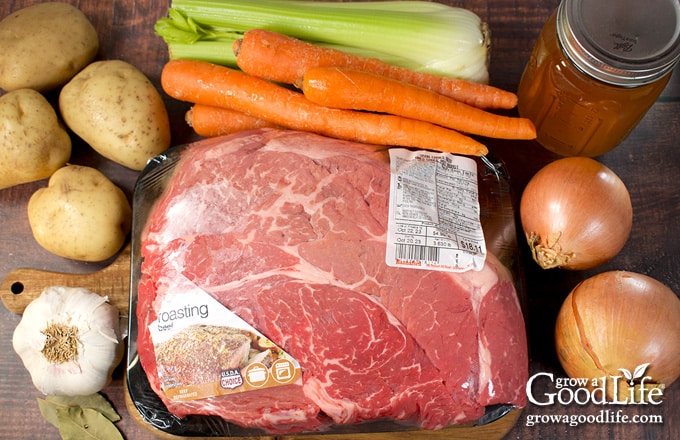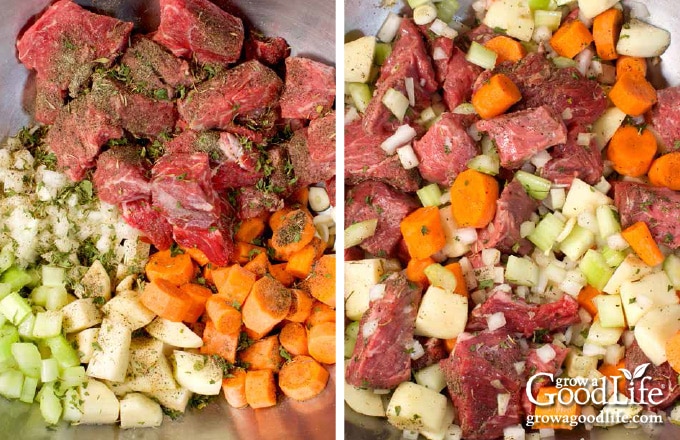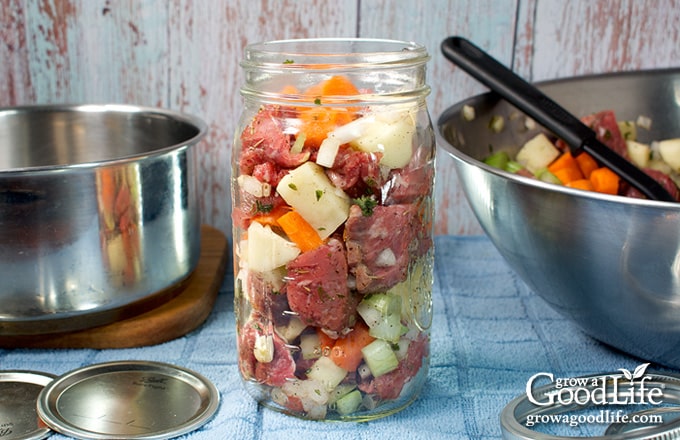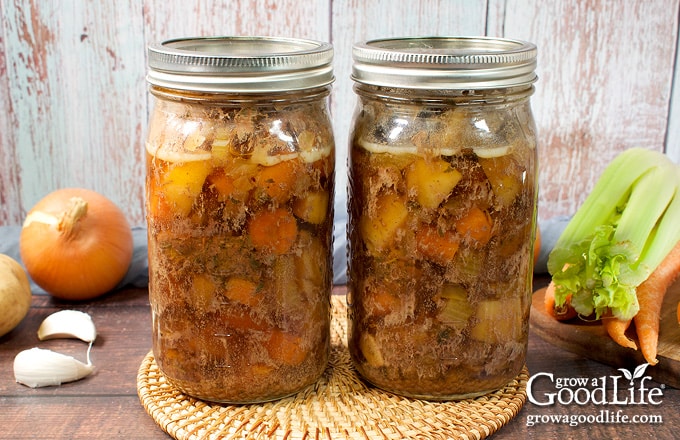Pressure canning beef pot roast right in the jar results in meat so tender it practically melts in your mouth, with all the rich flavors locked in, waiting for that moment when you decide it’s time to heat it for a satisfying, homemade dinner. Learn how to home can beef pot roast with this easy recipe.
Imagine having your very own stash of home-canned pot roast and vegetables ready to heat and serve a meal at a moment’s notice. This is an easy meal in a jar recipe that’s not only a time-saver at meal prep but is full of flavor.
Savor the Magic of Home-Canned Pot Roast in a Jar
Life’s pace can be relentless at times, leaving little time for preparing home-cooked meals every day. Enter the world of home-canned convenience with this pot roast in a jar recipe. It simplifies meal prep and delivers tender, flavorful beef with minimal effort.
In this raw pack recipe, the ingredients are combined and cooked right inside the jar as it is processed in the pressure canner. The result? Beef is so tender that it practically falls apart, infused with rich, aromatic flavors.
This is one of my favorite ways of canning beef. Preparing a delicious dinner is a breeze with these jars of goodness on the shelf. Simply heat and eat. If you like beef stew, you are going to enjoy this recipe.
Selecting the Perfect Ingredients
From choosing the ideal cut of beef to determining the right potatoes and balancing flavors with red wine and beef stock, each element plays a pivotal role in creating a flavorful meal. Here are tips for choosing good quality ingredients to achieve the perfect pot roast in a jar.

Beef Chuck Roast
The key to a delicious pot roast in a jar is the choice of meat. Opt for a beef chuck roast as your primary cut; it’s renowned for its flavor and tenderness when slow-cooked. Additionally, consider alternatives like chuck shoulder, bottom round roast, or rump roast. The secret here is the presence of marbling and connective tissue that will tenderize beautifully during the prolonged cooking process.
Potatoes
Not all potatoes are created equal for canning. Go for waxy or boiling varieties to ensure your potatoes hold up well. These types are low in starch and high in moisture, which helps them withstand the canning process without falling apart. Varieties like Yukon gold, white, and red potatoes are excellent choices for preserving your pot roast. New potatoes, being lower in starch, are also ideal for pressure canning. However, avoid Russet potatoes, which tend to break down when canned. You will need about 6 medium-sized potatoes to yield 2 cups of diced potatoes.
Carrots
When selecting carrots for your recipe, choose healthy roots with a minimum diameter of at least 1/2 inch. Smaller carrots are prone to disintegration during the canning process.
Onions
The type of onion you choose is up to you, as the intense onion flavor mellows during cooking and processing. Whether you prefer yellow, white, or red bulb onions, any will do. You’ll need about 2 medium-sized onions to yield 2 cups of chopped onions.
Celery
Celery adds flavor and texture to your pot roast. Approximately 4 stalks will give you 1 cup of sliced celery.
Red Wine
Red wine adds a flavorful dimension to your dish. Pick a dry red wine that you enjoy. You can substitute wine with beef stock if you prefer not to use wine.
Beef Stock or Broth
The choice of beef stock is important for flavor. You can make your own by simmering beef bones and vegetable scraps or opt for a store-bought beef bone broth or stock. When making your own, it’s a good idea to prepare it a day in advance, allowing you to refrigerate it overnight so the fat solidifies and can be easily removed before reheating. If you use store-bought beef broth, consider an organic option with low sodium and minimal additives. If the broth is sodium-rich, you may want to adjust the amount of salt in your recipe accordingly.
Steps for Canning Pot Roast
This safe canning recipe is the “Pot Roast in a Jar” recipe from the Simple One-Jar Meals section in The All New Ball Book of Canning and Preserving. Before you get started, it may be helpful to review this article on pressure canning at the National Center for Home Food Preservation website, along with the instructions for your pressure canner.
You can find the full recipe at the bottom of this article, but here are the detailed steps for preparing a beef pot roast:
Step 1: Prepare Your Canning and Kitchen Equipment
Before you begin, make sure you have all the essential kitchen tools and canning equipment ready to go. Here’s what you’ll need:
- Pressure canner with canning rack
- 4 quart-sized canning jars or 8 pint-sized jars if you prefer smaller portions
- Canning lids and bands (new lids for each jar, bands can be reused)
- Canning tools: jar lifter, canning ladle, funnel, and bubble popper
- Plus, basic kitchen supplies including a large prep bowl, medium pot, vegetable peeler, knife, cutting board, measuring cups, large spoon, and plenty of clean kitchen towels.
Wash everything in hot, soapy water, and rinse well. Check over the jars and eliminate any with nicks or cracks. Set aside until you are ready to use them.
Place the pressure canner on the stove and insert the canning rack. Add water per your pressure canner manufacturer’s instructions. For example, Presto requires 3 quarts, Mirro requires 2 quarts, and All American requires 2 to 3 inches.
Since this recipe calls for raw packing, warm the canner to just 140˚F. Fill the clean jars halfway with hot water, then place them on the rack in the canner. Cover and heat the canner on low heat. You can use a candy thermometer to check the temperature. Keep both the canner and the jars warm as you fill your jars.
Step 2: Prepare the Ingredients
Prep is easy with this raw-pack recipe. The ingredients are combined in a large bowl, then packed into the jars, topped with bay leaves, and covered with beef stock. Then, the jars are processed in a pressure canner to preserve and cook the pot roast.
Beef: Start by trimming the meat to remove any excess fat. Then, cut the beef into uniform 2-inch chunks. Add to a large prep bowl.
Potatoes and Carrots: Thoroughly wash the potatoes and carrots under clean running water, peel them, and rinse again. Then dice the potatoes, measure 2 cups of diced potatoes, and add these to the prep bowl. Similarly, slice the carrots, measure 2 cups of sliced carrots, and add to the prep bowl.
Celery: Trim off the bottom and any leafy tops from the celery. Separate the stalks and rinse them well under clean running water. Then, slice and measure 1 cup of sliced celery and add it to the bowl.
Onions: Peel and dice 2 cups of onions and add them to the bowl.
Garlic: Peel and slice the garlic, and add it to the bowl.
Add the Rest of the Ingredients: Add the red wine, thyme, salt, and pepper to the ingredients in the bowl. Set the bay leaves aside for now. We will add these to the jars as we fill them.
Mix Well: Thoroughly mix all the ingredients until everything is well combined.
Prepare the Beef Stock: Pour 2 cups of beef stock into a medium saucepan. Cover, bring to a boil, and keep it hot.

Step 3: Fill the Jars
Lay a dry towel on the counter. Place your lids, bands, canning tools, and bay leaves within reach near your workspace. Dampen a clean paper towel with a bit of vinegar to clean the rims of the jars before adding the covers.
Use the jar lifter to remove a jar from the canner. Pour out the water (save it for washing dishes), and place the jar on the towel. Keep the remaining jars in the canner so they stay hot.
Place the canning funnel on the jar and pack the beef mixture tightly into the jar, leaving about an inch at the top. Then add 1 bay leaf to quart jars and 1/2 bay leaf to pints, and top with hot beef stock, leaving a 1-inch headspace.
Run the bubble popper through the jar to release any air bubbles, then adjust the headspace again if necessary. Center a lid on the jar, place the band over the lid, and twist it on until fingertip tight.
Immediately place the jar back into the rack in the canner, and repeat with the rest of the jars until all the jars are filled, or you run out of food.

Step 4: Process in a Pressure Canner
Follow your pressure canner’s instructions for sealing, heating, and venting, and then process the jars for the times indicated in the recipe below.
Once the processing time is over, turn off the heat and allow the pressure to return to zero. Then, remove the cover and let the jars adjust to the change in temperature for about 10 minutes. Then, remove the jars and set them on a dry towel to cool.
Keep the jars upright. Tilting the jars could cause food to spill into the sealing area of the lid and prevent it from sealing. Also, don’t touch the rings or test the seals yet. The jars need time to cool undisturbed to seal properly. Let them cool completely for 12 to 24 hours.
Test the seals after the cooling period. Refrigerate any that failed to seal and use up in a few days. Before storing your jars, remove the rings and wash them thoroughly with soapy water to eliminate any residue. Then label and date the jars and find a cool spot to store the jars of beef pot roast. For optimal flavor, consume within 18 months.

Heat and Serve
Your jars of pot roast are fully cooked and just need to be heated before serving.
Open the jar, skim off any fat that has risen to the top, then pour the pot roast into a saucepan.
Fill the empty jar with 1 cup of water, add 2 tablespoons of cornstarch, cover, and shake to make a slurry. Add the slurry to the pot and warm over medium-high heat for about 10 minutes.
Add a dash of Worcestershire sauce, remove the bay leaf, ladle into bowls, season to taste with salt and pepper, garnish with fresh herbs, and enjoy hot.
Beef Pot Roast Canning Recipe
Pressure canning beef pot roast right in the jar results in meat so tender it practically melts in your mouth, with all the rich flavors locked in, waiting for that moment when you decide it’s time to heat it for a satisfying, homemade dinner.
- 4 pounds boneless beef chuck trimmed and cut into 2-inch chunks
- 2 cups peeled diced potatoes
- 2 cups peeled sliced carrots
- 2 cups diced onions
- 1 cup diced celery
- 4 cloves garlic sliced
- 2 cups dry red wine or substitute additional beef stock
- 4 teaspoons dried thyme
- 2 teaspoons salt
- 1 teaspoon ground black pepper
- 2 cups beef stock or broth
- 4 bay leaves 1 per quart or 1/2 per pint
Warm the Jars in the Canner:
- Place the jar rack into the pressure canner and fill it with water per your canner manufacturer’s instructions: Presto is 3 quarts, Mirro is 2 quarts, and All American is 2 to 3 inches.
- Fill the jars halfway with hot water and place them on the rack in the canner.
- Cover and warm the canner to 140˚F for raw packing, and keep warm until you are ready to fill the jars.
Prepare the Ingredients:
- Trim off visible fat from the meat, cut it into 2-inch chunks, and add it to a large prep bowl.
- Wash, trim, peel, and cut the potatoes, carrots, onions, celery, and garlic. Measure and add to the prep bowl.
- Add the red wine, thyme, salt, and pepper to the bowl, and mix all the ingredients well until combined.
- Pour 2 cups of beef stock into a medium saucepan, bring to a boil over medium-high heat, and keep it hot.
Fill the Jars:
- Lay a dry kitchen towel on the counter. Use the jar lifter to remove a jar from the canner. Drain the water in a separate bowl or the sink, and place it on the towel. Keep the remaining jars in the canner so they stay warm.
- Tightly pack the beef mixture into the jar, leaving a 1-inch headspace at the top. Add 1 bay leaf per quart or 1/2 bay leaf per pint. Then, top off with hot beef stock, leaving a 1-inch headspace.
- Run the bubble popper through the jar to release any trapped air, and adjust the headspace again if needed.
- Wipe the rim with a towel soaked in vinegar to remove any residue, center a lid on the jar, and screw on the band until fingertip tight.
- Place the jar back into the canner, and repeat with the remaining jars.
Process in a Pressure Canner:
- Place the lid on the canner and lock it. Leave the vent open, adjust the heat to medium-high, and bring the canner to a boil.
- Once boiling, let the pressure canner vent steam for 10 minutes, place the pressure regulator on top of the air vent, and let the pressure rise.
- When the canner has reached the correct pressure (10 pounds for weighted gauge or 11 pounds for dial gauge pressure canner), set a timer and process pint jars for 75 minutes and quarts for 90 minutes at altitudes of less than 1,000 ft.
- Adjust the pressure for your altitude if necessary (see chart below), and regulate the heat as needed to maintain a steady pressure.
- When the processing time is complete, turn off the heat and allow the canner to sit until the pressure drops to 0. Once the canner is depressurized, let it cool for an additional 10 minutes before removing the lid.
- Spread a dry towel on the counter, unlock the cover, and remove it by tilting the lid away from you so that steam does not burn your face.
- Allow another 10 minutes for the jars to adjust to the change in pressure. If the jars are still boiling vigorously, let them sit in the canner for another 5 minutes or until the boiling slows.
- Use the jar lifter to remove the jars from the canner and place them on the towel. Keep them upright, and don’t tighten bands or check the seals yet. Let the jars sit undisturbed for 12 to 24 hours to cool and seal.
- After 12 to 24 hours, check to be sure the jar lids have sealed by pushing on the center. The cover should not pop up. The jar failed to seal if the top flexes up and down. Refrigerate it and use it within a few days.
- Remove the screw-on bands and wash the jars in warm, soapy water to remove any residue. Then label, date, and store the jars in a cool, dark place. Use within 18 months for the best quality—yields 8 pints or 4 quart jars.
All times are at an elevation of less than 1,000 ft. Visit whatsmyelevation.com to check your elevation and adjust the processing time if necessary. Make the following adjustments for altitudes greater than 1,000 ft:
Dial Gauge Pints and Quarts at altitudes of 2,001 – 4,000 ft. increase pressure to 12 pounds, 4,001 – 6,000 ft. is 13 pounds, and 6,001 – 8,000 ft. is 14 pounds.
Weighted Gauge Pints and Quarts at altitudes of 1,001 ft. and above, increase pressure to 15 pounds.
Serving: 2cups | Calories: 500kcal | Carbohydrates: 14g | Protein: 60g | Fat: 14g | Saturated Fat: 5g | Cholesterol: 150mg | Sodium: 891mg | Potassium: 1286mg | Fiber: 2g | Sugar: 4g | Calcium: 52mg | Iron: 8mg
Grow a Good Life Guide to 40+ Meals in a Jar Pressure Canning Recipes
In this eBook, you will find 50 pressure canning recipes, including 44 meals, along with homemade stocks and bone broths. Recipes include soups, stews, chilis, beans, beef, pork, and poultry. Explore the world of preserving delicious home-cooked meals for all seasons.






